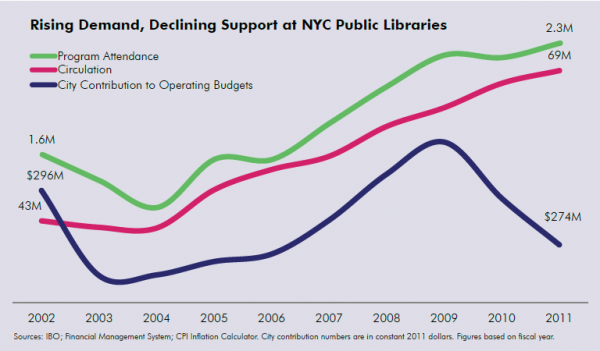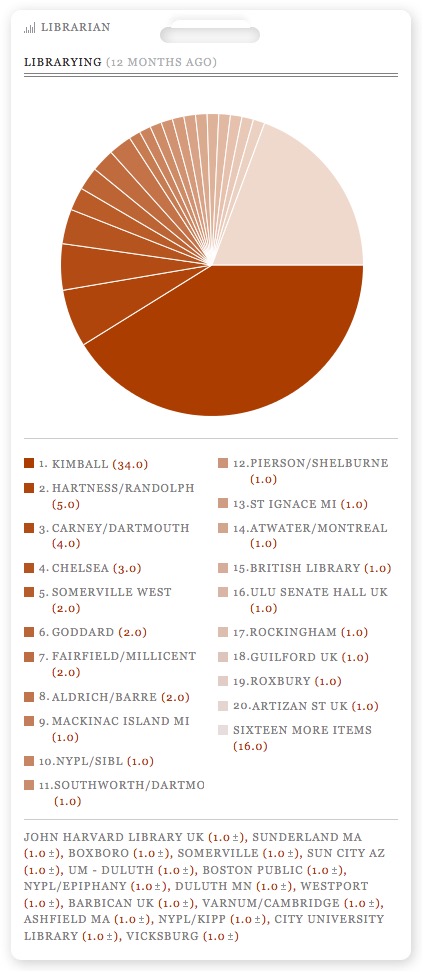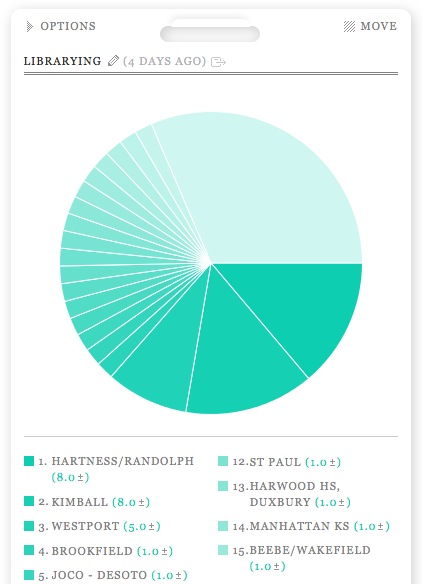I spoke to Vermonter Erica Heilman about what I like so much about libraries and technology and why they’re so important. Forty minutes of rural library banter that I think you might like.
Tag: libraries
2014 in libraries
I tracked the libraries that I visited this year, like every year. Previous years: 2013, 2012, 2011, 2010 and 2009 (and this little list of reviews from 2003)
I went to thirty-six different libraries in seven states and two non-US countries for eighty visits total. A bunch more than last year, but some were just for ukulele practice or tech planning sessions at a friend’s library. Here’s the short annotated list of what I was doing in libraries last year. Top three libraries are: my local public, my local academic and my summer local.
- Kimball – my local and also the place that hosts Ukulele Club
- Hartness at VTC – the best academic library anywhere near here. Good hours, great place to hang out.
- Carney – UMass Dartmouth – probably my favorite library building of all time
- Chelsea VT – helping with tech planning, I go here often
- Somerville West – did a talk and stopped by here another time. Lovely upstairs.
- Goddard – did some VLA website work here
- Fairfield/Millicent – One of the most amazing looking libraries in MA with some cool local lore
- Aldrich/Barre – Went to a few meetings, my favorite local library renovation story
- Mackinac Island MI – small and lovely with a great book sale and classic furniture
- NYLP/SIBL – keep waiting for them to close this but they haven’t yet
- Southworth/Dartmouth – they have a harpoon display here!
- Pierson/Shelburne VT – went to a meeting, small with a great puzzle collection
- St Ignace MI – killing time while stranded here, this is a great building where you wouldn’t expect it
- Atwater/Montreal – my favorite Canadian library
- British Library – got an awesome tour from Stella Wisdom
- ULU Senate Hall UK – got a great tour from Simon who no longer works there
- Rockingham VT – dropped off some things, stuck around to take a peek at this great place
- Guilford UK – one of the smaller local publics, nice with a watch museum next door
- Roxbury VT – helped with the automation project
- Artizan St UK – community center, small and busy
- John Harvard Library UK – had an odd section for Black Titles and a security guard
- Sunderland MA – great place to pass the time en route to or from Amherst
- Somerville MA – the other little library
- Boxboro MA – wifi to check email if you are early to visit Mom
- Boston Public – got a great tour by Tom Blake and saw some great stuff
- Sun City AZ – hanging out while visiting Jim’s folks
- UM – Duluth – Chihuly sculpture!
- NYPL/Epiphany – I always love the huge staircase in here
- Duluth MN – bizarre design but fun to hang out in
- Westport MA – great DVD collection, sort of an odd place
- Barbican UK – inside the funky Barbican, lots of great UK history books
- Varnum, Cambridge VT – stopped by randomly, folks were so nice and friendly
- Ashfield MA – gave a talk, enjoyed getting to see the place
- NYPL/Kipp’s Bay – small and in need of renovation but warm and welcoming
- City University, UK – stopped to check email en route to dinner, nice place, square dancing outside
- Vicksburg MS – neat renovation, fun kids area
Did not get to as many Vermont libraries as I had wanted to as part of my 183 project. Working slowly on maybe getting a statewide 183 project up and running with other members of the VLA. Looking forward to another year of library visiting.
Apologies for putting Duluth in MI accidentally. Now fixed.
2013 in libraries
I tracked the libraries that I visited this year, like every year. I have also done this in 2012, 2011, 2010 and 2009. Ten years ago I did a short list of library visits where I actually reviwed the places I’d been. Ah to have that much free time!
I went to thirty-eight different libraries in eleven states for fifty-six visits total. Just a little more than last year. I’m sure I have forgotten some. Here’s the short annotated list of what I was doing in libraries last year. Top three libraries are the same as every year: my local public, my local academic and my summer local. All great places.
- Hartness/Randolph VT – have not been here so much in the latter part of 2012, but this is still one of my favorite academic libraries.
- Kimball VT – my local, I don’t work here as much but still go here all the time.
- Westport MA – summer library, good for DVDs and other vacation-style stuff.
- Plymouth State NH – gave a talk, saw the library. A neat looking place, with a cool clock in the entryway.
- JoCo – Desoto KS – a tiny town with a great library where I checked my email while there was a rainstorm.
- Ashtabula Public OH – stopped by on a road trip and saw a lot of people with fishing poles. A quirky big library.
- St. Johnsbury VT – was here for the Hug the Library event during the unpleasantness.
- Minneapolis MN – hadn’t been here since the redesign. Enjoyed its shininess.
- Natick/Morse MA – killing time between friends and dinner, this was a great place to hang out.
- JoCo – Lackman KS – said hello to Josh Neff here!
- Beloit Public WI – lovely library, stopped in on a road trip and enjoyed myself. Fancy and shiny and new.
- St Paul MN – met a really nice librarian who told me some great history of the place.
- Harwood HS, Duxbury VT – my friend Meghan works here, stopped by the say hello.
- Manhattan KS – the public library when I was in town to hang out with my friend Donna.
- Beebe/Wakefield MA – such a neat place with a great bee-themed marketing campaign.
- Giamatti research center NY – Baseball Hall of Fame! My friend Paul worked as an intern, was fun to look through scrapbooks.
- KState KS – Donna gave me the grand tour and we got to see the basement.
- Nebraska Library Commission NE – said hi to the terrific Michael Sauers and gave a talk here.
- Brookfield VT – first time in a tiny library so close to home.
- Omaha Public NE – big and beautiful and got to meet the woman who does programming there.
- Roxbury VT – another favorite one-room library, haven’t been there since they got a bathroom installed.
- Somerville MA – killing time before the movies, this library is always busy and has a lot going on.
- KANEKO-UNO Library NE – an arty, somewhat private library, we took a brief look around. Very cool space & collection.
- Brown/Northfield VT – lovely merging of old and new buildings.
- Chelmsford MA – saying hi to Brian!
- Boston Public MA – a nice place to chill on a chilly Boston day.
- Providence RI – Surprised I hadn’t been here before. Neat old building, oddly underused, it seemed.
- Lawrence KS – in an old Borders building while they renovated. Quite busy.
- Windsor VT – checking out the seed library, great photos of local residents.
- Hartland VT – stopping by because I was in Windsor, before Amy got there, I think.
- New Bedford Pl MA – amazing building and we got to peek at some of the artwork they were restoring.
- Topeka/Shawnee KS – a great tour by David Lee King, consummate friend to librarians everywhere.
- Lincoln Public NE – stopped in before dinner with Michael, busy and overtaxed.
- Merriam Park – St Paul MN – smaller neat suburban library.
- Union/Tiverton RI – so cute, so small! Librarian so friendly!
- Ashland NE – stopped by when I was on a drive. Neat old building, soon to be renovated, amazingly friendly and helpful librarian.
- Carney/Dartmouth MA – gosh I love this weird place and I want to go back there all the time.
- Monmouth/Manalapam NJ – doesn’t look like much from the outside but has a lot going on.
I had such a good time visiting all of these places. I can get sort of schmaltzy sometimes but I think the public library system in the US is a truly terrific thing. Here’s to another great year of library visits.
theming it up for 2013
I’ve been doing a lot less public speaking this year, by choice. Just trying to travel less, be more of a homebody, be choosier. I just noticed that I haven’t mentioned any of the talks I have been doing or will be doing, so this is the post that clears that up. I have done three talks this year, all thematically related. You may be able to detect the theme….

- Encouraging a Culture of Openness in Libraries
- Open Library and Open Libraries – information for ALL the people
- Open Resources & Fair Use – Share ALL the things
Basically they summarize what’s been going on in the world of Fair Use the past year (a lot!) and then talk about what libraries are doing and what they can do. I also talk a bit about my work for Open Library where I am volunteering doing email support, helping people freely download and read ebooks through the Internet Archive‘s somewhat quirky interface. It’s challenging and fun. The two are related but maybe not in the way you’d think. People who are curious about Open Library or maybe helping out a little, please drop me an email and I can talk more about it at length.
A few upcoming talks, most on the far horizon. In August I’ll be in Lincoln Nebraska talking to rural librarians about technology use and training. In April of next year I’ll be at both TXLA (my favorite state conference I think, though there are many close seconds) and then at the Michigan Rural Libraries Conference on Mackinac Island. If you’re going to any of these, please let me know.
What is going on with New York’s public libraries?

I know people are probably pretty up on the general level of change, upheaval and consternation that are happening surrounding NYPLs big changes, most notably the changes at the Central Library but also the closure and sale of the Mid-Manhattan branch. You may not know about the closure and sale of some of the Brooklyn Public Library’s branches in which buildings are being sold and new spaces are being leased/rented to fit the library collections, programs and staff into. I know we’ve been fighting against some of the major downsides involved in leasing versus owning content, I think it’s important to think about the major downsides involved in renting rather than owning real estate. Here is some further reading about the Brooklyn plans.
- For Brooklyn PL, Planned Sale of Branches Promises Opportunity, Provokes Concern
- Saving Schools and Libraries by Giving Up the Land They Sit On
- Brooklyn Public Library plans to sell two dilapidated branches and move them into smaller locations
- BPL’s explanation of the plan
- Brooklyn Public Library to sell off Boerum Hill’s Carnegie branch
- Is the Public Getting Swindled by the City’s Short-Sighted School and Library Sell-Offs?
- Girl Scout troop fights to save Pacific Branch library
Want to get involved?
- Tweet or share this video. Girls speak out to save the historic Brooklyn library they love.
- Keep up with what Urban Libraries Unite are up to.
- Follow the Citizens Defending Libraries blog.
- The Queens Library is facing similar issues and has a petition that you can sign right on their website.
- Brooklyn Public Library has a Speak Up For Your Library page where you can share your voice.
- The People’s Budget NYC is a place you can vote on community suggestions for budgeting, extended library hours is at the top.
- The Pacific Branch has its own Save The Pacific Library page.
- Facebook options: Urban Libraries Unite, Save NYC Libraries

